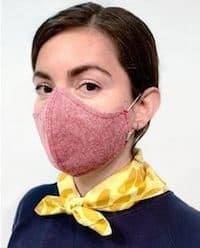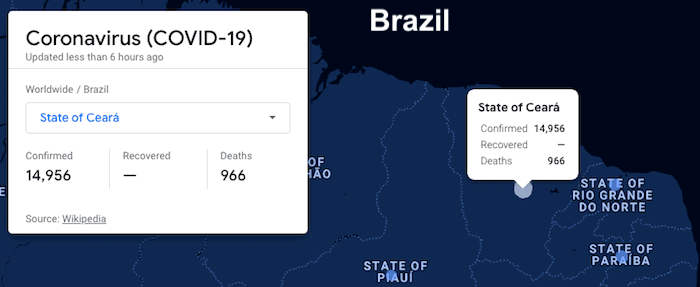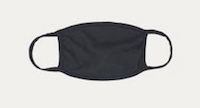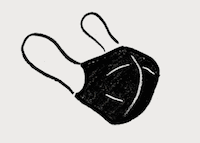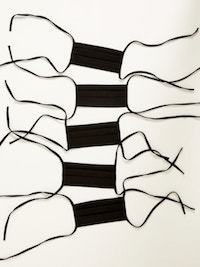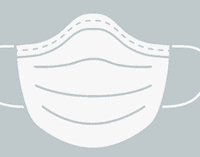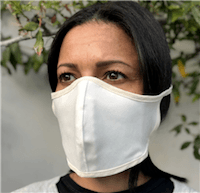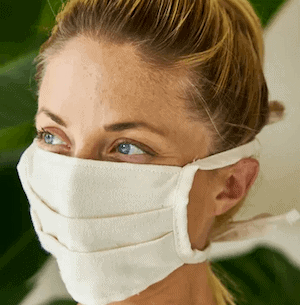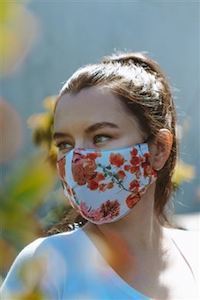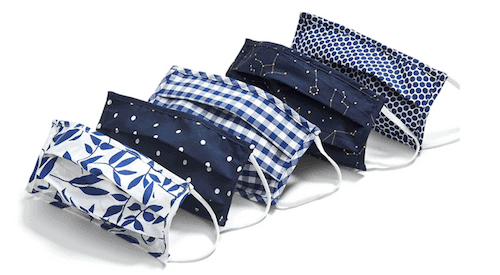Choose A Reusable Antiviral Face Mask To Protect Yourself and Others
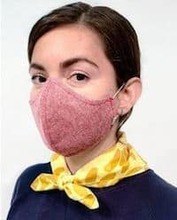
As many states in the U.S. prepare to reopen, we have a responsibility to ourselves and others to wear a cloth face mask while in public, preferably a reusable antiviral face mask. Learn which masks qualify, why you should wear them and how to properly put them on and take them off so you’d don’t infect yourself.
Check out my Covid Immunity CourseSurely you know that health professionals advise we wear cloth face masks when in public, and given that, it makes sense that we choose reusable antiviral face mask. This simply means that, ideally, the cloth face masks we choose should, at minimum:
- Be able to filtrate,
- Reusable for several times, or be
- Washable.
The CDC (Centers for Disease Control) adds some additional criteria, which I cover below. But first I want to impress upon you why this face mask thing is something important to do and get right.
CNN has a webpage that provides updated information about where states stand in their plans to reopen. Check it out if you’re curious about when your state may be planning to give you the green light.
Click here for the skinny on the five most populous states in the U.S.
#1 California
Gov. Gavin Newsom issued a stay-at-home order on March 19 that has no set end date.
The state will begin allowing scheduled surgeries. Newsom emphasized the surgeries being phased back in are important medical procedures like heart surgery or removing cancerous tumors that should not be neglected. Elective procedures like cosmetic surgery are still not a priority.
However, California is pulling back on issuing permits for events and activities, including protests, at all state facilities, according to the California Highway Patrol.
Newsom said May 1 that he is “days, not weeks” away from beginning to lift some restrictions in the state’s stay-at-home order.
#2 Texas
Gov. Greg Abbott had ordered all Texans to stay home through April 30.
On May 5, he announced a reopening of certain businesses starting May 8.
Salons are allowed to open May 8, with restrictions such as one customer per stylist and 6 feet between stations and customers waiting. Masks are strongly recommended by not mandatory.
#3 Florida
Florida will reopen certain businesses through much of the state on May 4 except in the counties of Broward, Miami-Dade and Palm Beach, according to Gov. Ron DeSantis.
Starting May 4, restaurants may offer outdoor seating with six-foot space between tables and indoor seating at 25% capacity. Retail can operate at 25% of indoor capacity, and bars, gyms and personal services such as hairdressers will remain closed. Churches remain on “voluntary social distancing,” and movie theaters remain closed. The state’s stay-at-home order ends on April 30.
#4 New York
Gov. Andrew Cuomo issued a “New York State on PAUSE” executive order which took effect on March 22. Nonessential businesses are ordered to stay closed until May 15.
New York has joined a coalition with the Northeastern states of New Jersey, Connecticut, Pennsylvania, Delaware, and Rhode Island and Massachusetts to coordinate the reopening of the economy, according to a from Cuomo’s office.
“Now that we’ve shown we can flatten the curve and our efforts to control the spread of the virus are working, we must focus on a smart, effective plan to un-pause New York,” Cuomo said last week. “The first part of the plan is to do no harm – don’t let that infection rate go up to the best of your ability and don’t lose the progress that we have made. Second, now that we have some stability in our health care system after a weekslong overdrive, we continue to strengthen that system and ramp up testing and contact tracing to identify those who are sick and isolate them so they don’t transmit the virus to others. Then we can focus on phasing an economic return to the new normal — but we need all those activities going on at the same time for our plan to un-pause New York to work.”
#5 Illinois
Gov. J.B. Pritzker issued a modified stay-at-home order that went into effect on May 1 and extends through the end of the month. The order allows more flexibility “where it is safe” to do so, according to Pritzker.
This new order allows residents to leave their home for essential activities, including for health and safety, for necessary supplies and services, for outdoor activity, for certain types of work, to take care of others, and to engage in the free exercise of religion.
“All we were trying to do was to make more explicit that people do have the right to gather in a group of 10 or less,” he said. “As long as you are social distancing.”
State parks, golf courses, retail stores, and garden centers are some of the few places that are reopening with strict social measures.
Non-urgent surgeries that have been put off due to the crisis can also now be scheduled in surgery centers and hospitals, according to the governor.
The New York Times also has a map indicating which states are reopening and which remain shut down. Most states have partially reopened or plan to reopen soon.
This means many millions of people worldwide are about to leave the safety of their social isolation and re-enter the world. And because the COVID-19 disease has not only not disappeared, but is expected to surge again, the vitally important question worthy of your consideration is:
What can I do to stay safe?
I’ll answer that question in a minute, but first I want to underscore what we face as we emerge from our solitary lives.
Contents
Has “The Curve” Really Flattened In the U.S.?
In a word… no!
As reported by journalist , you shouldn’t be fooled by the so-called “flattening curve”, which refers to the point when the apex of the curve representing COVID-19 infections peaks, and thereafter flattens, and then declines.
Mr Lash makes the point that we shouldn’t be lulled into a false sense of complacency, because the data that indicates a flattening infections curve for the nation as a whole is currently misleading. For instance, when you exclude the New York City data, the graphs tell a different story:
Credit: NYTimes.com
Credit: NYTimes.com
Mr. Lash makes the point that:
“What’s happening is a series of “mini-epidemics,” each following the predictable curve that rises and falls as the virus runs out of susceptible people to infect. Meanwhile, the national numbers offer a deceptive picture: All the mini-epidemics are laid on top of one another, coming at different moments and infecting different populations.”
This is the conclusion of forecasters who are projecting more deaths from COVID-19 going forward. A leaked document obtained by The New York Times projected more than 3,000 people could die each day by the end of May. The tail-end of the national epidemic is not materializing.
Obviously, then, we cannot blithely go back into the world at large and feel safe without taking specific precautions. The experts exhort us to stay safe by reducing our chance of becoming infected with COVID-19 by:
- Washing your hands frequently.
- Continue with social distancing — remain six feet apart.
- Wearing a cloth mask; preferably a reusable antiviral face mask.
We’ll dive into mask wearing thing in a moment, but first I want to suggest a more relevant way to assess what’s going on with COVID-19 infections. In addition to tracking when the states reopen provided by CNN and New York Times, as I showed you above, you can drill down to see what’s happening in the county of your state in the U.S.
For those of you who don’t live in the U.S., Google has a frequently updated map that shows COVID-19 cases worldwide, by country, and by some regions within a country.
By way of example, and curious about how Brazil was fairing. Given that Brazil’s leadership denies that COVID-19 is something to worry about, and that cases there have spiked to 135,106, including 9,146 deaths (as of early May, 2020) — I selected “Brazil” and randomly clicked on the state of Ceará. Here’s how it looks:
I encourage you to use this Google resource to keep up with COVID-19 infections in your area.
Now that you have an appreciation that:
A) States in the U.S. and other countries and regions around the world, are reopening and you’re going to be exposed to a lot more people who may be infected with COVID-19, then…
B) You might want to double down on wearing cloth face masks, particularly reusable antiviral face mask, which simply means face masks that can be reused multiple times or washed, and have cloth material that’s resistant to viral infection.
The Real Deal With Face Masks
In a nutshell, the CDC (Centers for Disease Control) recommends that you wear a face mask when outside, especially if in an enclosed area that contains people. This is not only to protect yourself from others who might be infected with COVID-19, but to help you not spread the virus if you’re infected, but don’t realize it.
“We now know from recent studies that a significant portion of individuals with coronavirus lack symptoms (“asymptomatic”), and that even those who eventually develop symptoms (“pre-symptomatic”) can transmit the virus to others before showing symptoms,” says the CDC.
The COVID-19 virus can spread between people that are close to each other, through touching, coughing, or sneezing. To minimize spreading the virus, the CDC recommends wearing cloth face coverings in public settings where other social distancing measures are difficult to maintain (e.g., grocery stores and pharmacies) in areas of significant community-based transmission.
Incidentally, the cloth face coverings recommended are not surgical masks nor N-95 respirators; these continue to be in short supply, are essential for healthcare workers, and must continue to be reserved for them.
I took the time to share with you the resources listed above that report on confirmed COVID-19 infections in your geographical area, so that you double down on wearing a face mask should you live in an area that has many infections, or the infections are rising.
Next up are some details about which face masks to use, a few examples, and how to properly put them on and take them off.
Select A Reusable Antiviral Face Mask
To reiterate: The CDC has advised wearing a cloth face covering if out in public where it could be hard to properly socially distance. Cloth face masks, however, do not replace the need for washing hands or social distancing, and they absolutely do not alone prevent the spread of COVID-19. They can help reduce the chance of infecting others if you’re sick, but will not fully protect you from contracting the virus from someone else.
The CDC outlined five criteria to help guide your selection of a cloth face mask. It must:
- Fit snugly (but comfortably) against your face.
- Be secured with ties or ear loops.
- Include multiple layers of fabric.
- Allow for breathing without restriction.
- Be washable without damage or shape change.
NBC News has a guide for selecting cloth face masks. It features Scott Segal, MD, MHCH, chair of anesthesiology at Wake Forest School of Medicine, who led a recent study that found different types of cloth affected the ability to filter out particulates in different ways.
The best-performing design was constructed of two layers of high-quality, heavyweight “quilter’s cotton” with a thread count of 180 or more, and those with especially tight weave and thicker thread such as batiks. A double-layer mask with a simple cotton outer layer and an inner layer of flannel also performed well.
The bottom line is that there’s a wide variation in the quality of homemade face masks, some of them demonstrating as little as one-percent filtration.
According to Dr. Segal’s study:
- The most effective design, according to the study, was a dual-layer and heavyweight cotton mask with a thread count of 180 or more.
- A double-layer mask with a simple cotton outer layer and inner layer also performed well.
- Poor performers in the study: single-layer masks and double-layer masks of low-quality, lightweight cotton.
With that criteria in mind, what follows are the cloth face masks that fit Dr. Segal’s criteria, as reported by NBC News, and listed by me from the least to most expensive. Note: cheaper isn’t necessarily better, as the more expensive face masks may fit better, offer better protection, be reusable or washable.
Click on the links to learn more about each:
As if that selection isn’t enough, know that the Old Navy brand just launched a large assortment of cloth face masks for adults and children. Note: to my knowledge that these masks haven’t been evaluated for their filtration capacity.
Made of extra fabric leftover from the brand’s clothes, Old Navy’s face masks come in packs of five and retail for $12.50. The masks in each pack are made with different patterns, including Old Navy staples like checkered, plaid, and nautical prints. By using excess material from the clothing manufacturing, the brand says it can produce the masks in the most sustainable way possible.
The websites selling these masks all say that an order can take a week or more to deliver, given demand, so don’t wait till the last minute to place your order.
How To Put On and Take Off Your Antiviral Face Mask
Sit back and watch UC San Francisco emergency care physician Jeanne Noble, MD explain why everyone should wear a face mask, and to demonstrate step-by-step how to safely don (put on) and doff (take off) masks of different types.
Your Takeaway
Remember these four things:
- The number of people that will get infected by COVID-19 is going to increase, especially as more of us emerge from the protection of our homes and interact with others again. That needs to happen in order to develop herd immunity; however, we want that to occur with minimal impact to health care facilities and to those who get infected. (Read How To Boost Your Immune System To Fight Viruses Like Coronavirus.)
- To stay safe, we must continue to wash our hands frequently, practice social distancing (six feet apart), and wear cloth masks, preferably reusable antiviral face mask, unless you have access to and can afford buying them on an on-going basis.
- Try to find a reusable antiviral face mask that you can wash or use several times before discarding, and that has strong a filtration capacity.
- Be sure to pay attention how to put on and take off the mask safely.
Please be sure to share this post with anyone who needs to get a reusable antiviral face mask, or thinks they don’t need to wear one at all at anytime.
Also, I’ve written several articles to help you understand COVID-19 and what to do to stay safe:
- Your Aging Immune System and COVID-19
- How To Test Yourself for Coronavirus at Home
- How To Boost Your Immune System To Fight Viruses Like Coronavirus
- Be Productive At Home During The COVID-19 Scare
- Why Influenza and COVID-19 Pandemics Will Not Disappear
- Short Home Workouts You Can Do Now With Surprising Results
- Are COVID-19 and Obesity Linked?
Stay Safe!
Last Updated on April 11, 2023 by Joe Garma

